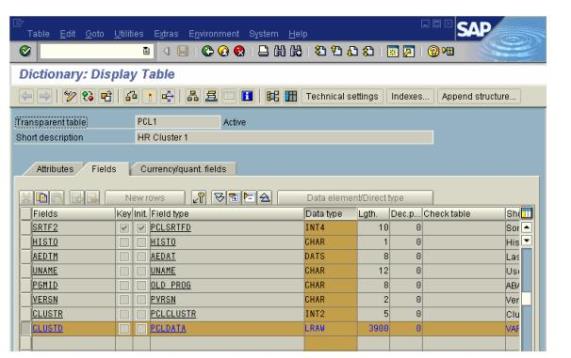Pooled and Cluster Tables
This section describes TDV SQL support for SAP pooled and cluster tables.
| • | Understanding Pooled and Cluster Tables |
| • | HR Clusters |
Understanding Pooled and Cluster Tables
SAP uses three approaches to table storage:
| • | Transparent tables are stored as regular tables in the back-end database. |
| • | Pooled tables are several logical tables stored as a single table, or “table pool,” in the database. |
| • | Cluster tables are logical tables stored as a single table, or “table cluster,” in the database. |
The difference between table pools and table clusters is that the component tables of a table cluster share common keys, while component tables of a table pool do not.
The TDV can access all three types of SAP tables and all views based on them.
|
Table Type |
Table Class |
Supported? |
Examples |
|
Transparent |
TRANSP |
Yes |
KNA1, AFKO |
|
Cluster |
CLUSTER |
Yes |
BSEG, BSET |
|
Pooled |
POOL |
Yes |
A001, FINK |
|
View |
VIEW |
Yes |
V_T001, CUSPROJ |
Some tables in SAP have misleading names. For example, “HR Cluster 1” (PCL1) is actually a transparent table. To ascertain the storage type of a table, go to the ABAP Dictionary (transaction code SE11), provide the name of the table, and display its technical settings.
Working with the definitions provided above, TDV is able to access all three types of tables: transparent, pooled, and cluster. They all look to TDV like any other table resource. However, pool and cluster tables are more likely to contain columns that TDV cannot read:
Types LRAW and RAW—Due to limitations of the SAP function RFC_READ_TABLE, which TDV uses to access SAP tables, the column types RAW and LRAW are not properly handled.
Columns greater than 512 bytes—RFC_READ_TABLE does not support any type of columns that are greater than 512 bytes. Such columns are ignored during introspection, and a WARNING message is added to the log.
HR Clusters
HR functional areas contain several transparent tables with columns of type RAW and LRAW. Many have “cluster” in their names even though they are not cluster tables. “HR Cluster 1” (table PCL1) is one example. The inaccessible CLUSTD column is highlighted below.

Because SAP is unable to provide TDV access to RAW columns or columns of this length, administrators must write custom BAPIs to expose their data. TDV can then access the custom functions like any other resource.